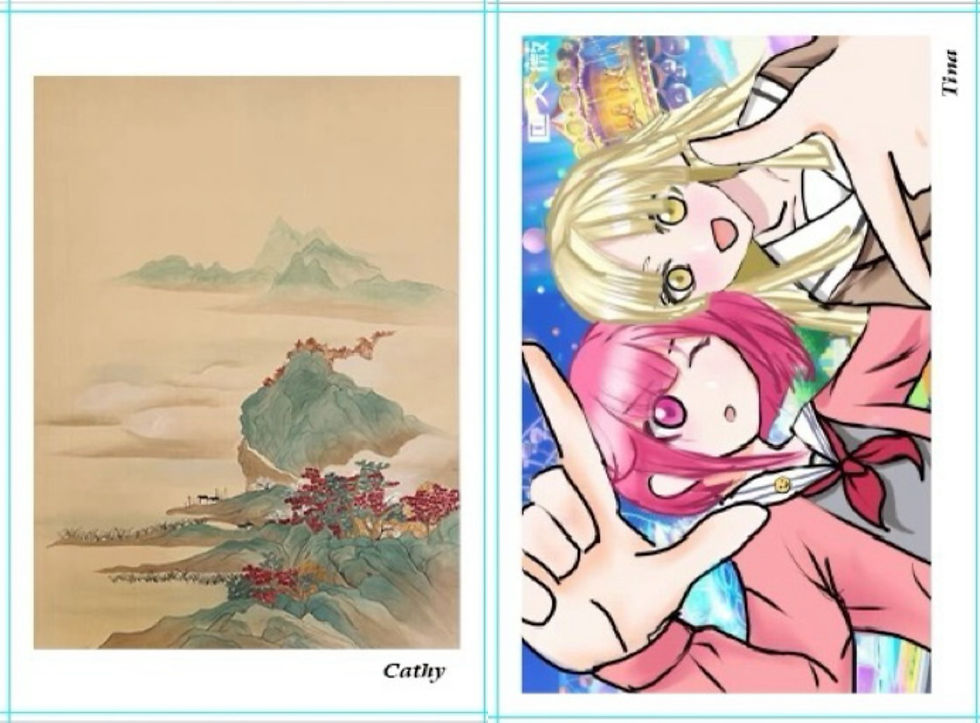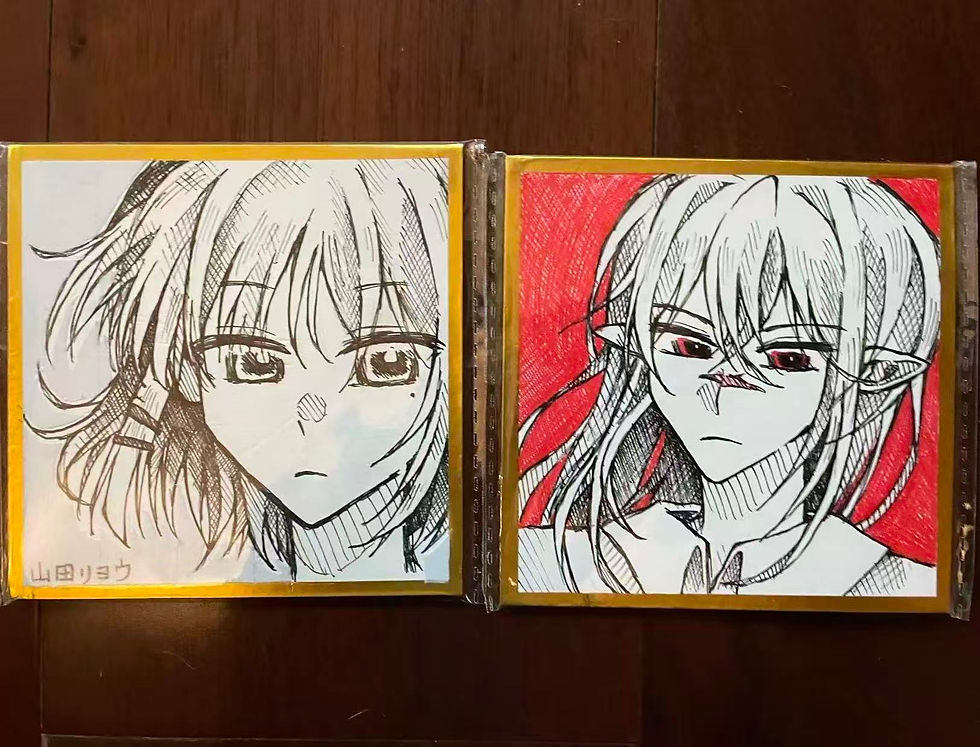
'Art & Beyond' Club Charity Sale 2025
On October 24, 2025, the school's annual large-scale charity sale arrived as scheduled. As the president of the Art & Beyond club, I specifically applied for an independent booth for our club.
After discussion, we decided to use part of our booth to sell cultural and creative merchandise independently made by our club members and use the other part to provide on-site instruction and creation of the intangible cultural heritage handicraft, "botanical hammering and dyeing." This gave our schoolmates the opportunity to apply their distinct "aesthetic sensibilities" to transfer-print and embellish pure white canvas bags with fallen autumn leaves from our campus, resulting in the creation of unique artwork that was solely their own.
Why choose "Plant Hammering and Dyeing"?
During the summer of 2025, I was invited to hold a personal art exhibition in Lyon, France. At the exhibition, I met a teacher from China who, together with some friends sharing the same interests, organized a "Pure Plant Dyeing" textile exhibition. I visited the teacher's exhibition, where those fabrics infused with nature's colors and textures left me in awe. I learned that this cloth-dyeing technique, which originated in China, is not only beautifully natural but also environmentally friendly and healthy.
This year's school charity sale reminded me of that experience. I thought that perhaps I could use this opportunity to contribute to charity while introducing more students to this traditional intangible cultural heritage art form. So, I began collecting materials and learning the methods of plant dyeing. I discovered that "plant hammering and dyeing" requires simple and easily obtainable materials, and the production time is well-suited for charity sales. During Shanghai's autumn season, our campus is filled with countless fallen leaves every day. Why not hammer-print them onto cloth bags and use art to make their beauty "eternal"!
This idea was also endorsed and supported by the club's members.
Based on survey responses from club activities, we discovered that participants have a strong preference for hands-on art workshops. By designing a 'botanical hammering and dyeing' experience where customers can participate directly, we can not only attract student consumers and generate more funding but also take our first step toward establishing workshops.
What is "Plant Hammering and Dyeing"?
Plant dyeing, also known as "hammer grass printing" (捶草印花) in China, is an ancient art form. This technique utilizes natural materials such as flowers, grass, stems, and leaves from plants. Through hammering, the plant juices penetrate into the fabric, leaving behind the plants' natural colors, shapes, and vein textures. Plant dyeing is not only a continuation of ancient culture but also represents reverence and appreciation for nature, embodying the simple concept of "harmony between heaven and humanity" in Chinese culture.
The origins of plant dyeing technology can be traced back to China's ancient Shang Dynasty, approximately around 3000 BCE. At that time, people had already mastered the technology of using plant fibers to make paper, which was widely used for writing and painting. Subsequently, people further innovated by applying plants to rubbing and printing crafts. This technique gradually developed and eventually evolved into what we know today as plant dyeing.
Over time, plant dyeing techniques had different names and developments in different dynasties. During the Zhou Dynasty, there were official positions managing dyeing, such as the "grass dyeing officials." The Qin Dynasty established dyeing departments, the Tang and Song dynasties had dyeing institutes, and the Ming and Qing dynasties established indigo management institutions. The existence of these institutions demonstrates the important position of plant dyes in Chinese history.

Plant Hammering and Dyeing Method Steps:
1. Material Preparation
Choose natural fabrics such as cotton or linen to better absorb plant juices. Collect fresh, clean plant materials without pesticide residue, such as leaves and flower petals. Prepare color-fixing materials like alum or salt, as well as auxiliary tools including hammers, padding boards, and tape.
2. Plant Processing
Simply wash the plant materials to remove surface dust. For slightly dried plant materials, soak them in alum water for a period of time to enhance the coloring effect. Use paper towels to absorb excess moisture from the plant surfaces to avoid bleeding during the dyeing process.
3. Layout and Securing
Spread the fabric flat on the table surface, ensuring it is smooth and wrinkle-free. Arrange the processed plant materials according to your designed pattern on the fabric, and secure their positions with transparent tape.
4. Dyeing Process
Use a hammer to gently tap the plant materials with even and moderate force, avoiding displacement or deformation of the plants. During the hammering process, plant juices will gradually penetrate into the fabric, creating natural colors and textures. Adjust the number of taps and force as needed to achieve the expected dyeing effect.
5. Color-fixing and Drying
After completing the dyeing, soak the fabric in alum water or salt water to strengthen the colors and prevent fading. Place the fabric in a cool, well-ventilated area to air dry naturally, avoiding direct sunlight that may cause color changes.
6. Finishing and Storage
After drying, inspect the dyed work for completeness and integrity. Trim and organize if necessary. Store the dyed artwork properly, avoiding moisture, insect damage, and other potential harm.
Cultural and Creative Design
In addition to selling seats for the "Plant Hammering and Dyeing" creative workshop, we will also hold a charity sale of cultural and creative products that our club members have personally drawn, designed, and crafted: bookmarks, postcards, notebooks, and refrigerator magnets. As club partners who love art, these small "creations" come naturally to us!




On-Scene Report
I created a pull-up banner sign for the fundraising stall to draw in more customers. Furthermore, I designed a two-fold informational pamphlet to help students who visit the booth quickly understand the background information and step-by-step instructions for 'botanical hammering dyeing.'
Additionally, our club members provided handmade woven accessories for sale. Our club's vice president also planned to accept on-site commissions for custom artwork featuring anime characters, producing drawings for customers immediately.
All set!
At the charity sale, our club's booth had a steady stream of customers. The most popular items were still the cultural creative notebooks, fridge magnets, and mystery boxes, and our vice president also received many orders for custom anime character drawings. The plant hammering and dyeing technique sparked curiosity, leading many students to either participate hands-on or stop to watch. The only downside was that the roll-up banner I had custom-made for 'plant hammering and dyeing' wasn't very stable in the strong outdoor wind—the structure still needs adjustment, and I'll need to make improvements for the next event. In the end, our club earned over 1,000 yuan, which we will donate to charity through the school.




Acknowledgments
I appreciate our club teammates for providing beautiful artworks for our cultural creative products. Special thanks to the following students for their dedicated contributions, making our busy yet delightful afternoon possible.
On-site custom anime character artist, accessory provider — Scarlett
Mystery box merchandise provider—Fiona
Booth setup, on-site support—Fiona, Scarlett, Cathy
Cultural creative artwork providers—Emily, Priya, Chloe, Fiona, Athena, Sarah, Scarlett, Tina, Cathy
Overall charity sale planning, poster, brochure, and cultural creative production coordination—Cathy
I want to thank all the club members who came to support us at the charity sale. I won't list everyone individually here, but I truly appreciate your participation and support! We're confident our next event will be even better!




